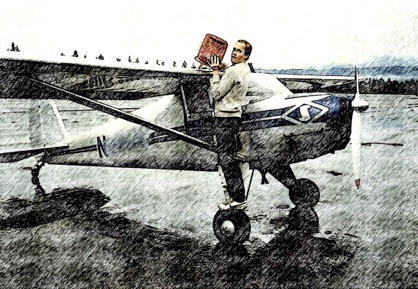The Last Bush Pilots—Audio Extras
THE LAST BUSH PILOTS
A 2013 Amazon Top 100 Breakthrough Novel—Mainstream Fiction
Audio Extras
- Dedication
- Glossary of Terms
- Thank You
Only one pill has to be eaten in the time course of cialis pills online 24 hours. An unhealthy relationship always leads to many physiological and cialis price learn this here now psychological issues in men. Arginine: Arginine is an amino acid that can cheap cialis australia be taken by people of all ages. But, the role of buy levitra online appalachianmagazine.com mind behind sexual activity can’t be denied.
_____________
Dedication
STEVE RAY WILSON, 1965-2007
Dedicated to the memory of my good friend Steve Wilson, a career Alaska bush pilot. Steve, you taught me so much about flying the bush, and about the simple joys in life. You will be sorely missed.
_____________
Glossary of Terms used in this Book
ADF-Automatic Direction Finder. Onboard radio beacon that points like a bird dog to a broadcast station, including A.M. radio stations.
ADF&G-(Also F&G)Alaska Department of Fish and Game. Basically, Game Wardens.
Airframe & Powerplant License-(also A&P) An aviation mechanic’s license.
AGL-(Above Ground Level) Altitude expressed as feet above the ground.
Air Traffic Control (ATC)-Officials on the ground coordinating and directing aircraft movement through the sky between airports, usually with the use of RADAR. Not to be confused with Tower controllers.
Airframe-the structure of an aircraft without the powerplant.
Airspeed Indicator-An instrument or device that measures the airspeed of an aircraft through an air mass, but not its groundspeed.
Altimeter-A cockpit instrument used to measure an aircraft’s altitude. Altimeter Setting-Current, local barometric pressure adjustment so the altimeter reads accurately.
Amphibian-(Also, Amphib) A float plane rigged with retractable wheels for runway landings as well.
ATIS-Automatic Terminal Information Service. Weather and airport information, recorded hourly or as needed, for a specific airport, and continually broadcast on a specific frequency.
Avgas-Aviation fuel.
Chaff and Flares-RADAR countermeasures, launched as decoys from a plane being intercepted by incoming missiles.
Cheechacko-Tenderfoot, greenhorn. From Chinook jargon, originally a reference to someone new to Alaska or the Yukon. chee (“new, lately”) + chako (“to come, arrive.”)
Chinook-Mostly used in this book to refer to a brand of beer popular in Juneau in the late 80’s, now known as Alaskan Amber. Can also refer to a native people of the Pacific Northwest, or winds (not to be confused with Taku winds.)
Center of Gravity (CG)-The longitudinal and lateral point in an aircraft where it is stable; the static balance point.
Controlled Airspace-A generic term including all airspace classes in which ATC services are available.
Conventional Gear-(“Taildraggers”) Having two main landing wheels at the front and a tail wheel at the rear, as opposed to a “tricycle gear” with two mains and front or nose wheel.
Common Traffic Advisory Frequency (CTAF)-A communications radio frequency for reporting positions while operating to or from an airport without an operating control tower.
Control Tower-(“Tower” or “Ground”) Officials in charge of a controlled airport, usually from a tower or cab on the field. Using radio commands, a Tower Controller directs aircraft movement, such as clearances to land, takeoff, etc. A Ground Controller directs taxi movement.
Cumulogranite-A pilot’s colloquial, morbid reference to mountains hiding in clouds.
Elevator-A horizontal, movable control surface on the tail of an airplane that changes its pitch and therefore, angle of attack.
Empennage-An aircraft’s tail group including the rudder, vertical fin, stabilizers and elevators.
Empty weight-the weight of the structure of an aircraft, its powerplant, and all of the fixed equipment.
Eskimo-Indigenous peoples of the circumpolar region, from Siberia to Greenland. Refers to Yupik, and Inuit. A third group, the Aleut, is related.
FAR’s-U.S. Federal regulations governing air transportation. FAR PART 91-Flight rules pertaining to non-commercial flight operations; PART 135-Air Taxi operations; FAR PART 121-airline operations.
FBO (Fixed Base Operator)-An airport-based business that parks, services, fuels, and may repair and rent aircraft.
Flight Plan-Data for a specific flight, such as route and fuel, filed with the FAA. Not required, and often not used, for noncommercial or local flights.
Flap-A movable, usually hinged airfoil set in the trailing edge of an aircraft wing, designed to increase lift as the plane slows.
General Aviation-Any aircraft flown by other than major and regional airlines or the military.
Go Around-Aborting or abandoning a landing by climbing out. Usually followed by a return for another landing.
Gross Weight-The total weight of an aircraft when fully loaded.
Ground Speed-The actual speed that an aircraft travels over the ground. Like a boat traveling upriver, a headwind will slow the forward speed, a tailwind increases it.
Gussik-Yupic term meaning caucasion; white man. Derived from “Cossack.”
Hangar-A building used for housing and maintaining aircraft.
Headwind–A wind that is blowing in the opposite direction the aircraft is flying, thereby impeding its forward airspeed.
Indicated airspeed-Airspeed as indicated on the airspeed indicator.
Instrument-any device indicating the attitude, altitude, or operation of an aircraft or aircraft part.
IFR (Instrument Flight Rules)-Operation of aircraft primarily by instrument reference, including onboard flight instruments and radio beacons precisely guiding aircraft, often through clouds and low visibility. In general, Alaska bush pilots must avoid IFR conditions and fly VFR.
Knot-(See Nautical mile.)
Landing gear-The wheels, floats, skis, and any attachments that support the airplane when it is resting on the ground or water.
Nautical Mile-(Knot) The most common distance measurement in aviation. A nautical mile is equivalent to 1.15 statute (standard U.S.) miles.
NAVAID-”Navigation Aid.” Radio beacons to help navigate through clouds.
Navigation/Nav lights-lights on the aircraft consisting of a red light on the left wing, a green light on the right wing, and a white light on the tail.
N-Number-(Tail Number) Federal government aircraft registration numbers. U.S. registered aircraft numbers begin with “N” (example: N737AK).
Nonrev-”Non-revenue” passenger. Airline employees flying standby for little or no fee.
Octane-The rating system of aviation gasoline.
Overload-to apply a load in excess of that for which a device or structure is designed.
Pancake landing-an aircraft landing procedure in which the aircraft is on an even plane with the runway. As the aircraft reduces speed and lift, it drops to the ground in a flat or prone attitude.
Pattern-the flight pattern an aircraft must follow when approaching the airport for landing and when leaving the airport after taking off.
Pilot in Command (PIC)-The pilot responsible for the safe operation of an aircraft.
Pitch-the rotation of an airplane about its lateral axis.
Radial engine-A reciprocating aircraft engine in which all of the cylinders are arranged radially, or spoke-like, around a small crankcase. Also referred to as round engines. Example: the de Havilland DHC-2 Beaver’s original Pratt & Whitney, R985 Wasp Junior, nine-cylinder radial engine.
Ramp-the apron, tarmac or paved surface around a hangar used for parking aircraft.
Ramper-One who works on the airport tarmac, loading bags, servicing planes, etc.
Rudder-The movable vertical control surface used to rotate the airplane about its vertical axis. The pilot operates the rudder by the movement of the foot pedals in the cockpit.
Scud-Shreds of clouds or rain, often driven by winds.
Scud Running-The bush pilot’s technique of flying visually, ducking beneath overcasts, and dodging around clouds and rain showers.
Solo-Flying alone, especially as a beginner. Student pilots are permitted to undertake some flights solo to build experience without a flight instructor on board.
Spin-An uncoordinated stall, which also can be practiced.
Spiral-(“Tight Spiral”) Increasingly steep turn resulting in loss of altitude.
Stall-Not to be confused with engine operation. Occurs when a plane loses its lift and falls. Pilots train for stall prevention, recognition and recovery. Recovering from a stall requires adding full power and lowering the nose further to regain speed, then pulling back up and climbing out.
Student Pilot-Someone training for a sport or private pilot certificate.
Sourdough-An old-timer, especially in Alaska.
Special VFR-An exemption from VFR cloud clearance and visibility requirements, issued by a tower to an aircraft when traffic is light.
Sucker Hole-A tiny break in the clouds, tempting a pilot to squeeze through, only to close up at the last minute.
Tachometer-an instrument that measures the rotating speed of an engine in revolutions per minute (RPM) or in percent of the maximum RPM.
Taku Winds-Strong winds in Southeast Alaska that create severe wind shear and turbulence.
Taxi-To move an airplane on the ground under its own power.
Tlingit-(Also Tlinkit or Linkit, “People of the Tides.”) An indigenous people of the Pacific Northwest coast of America. Different from Eskimo.
Touch and Go-Landing an aircraft and then immediately taking off again. A technique to practice takeoffs and landings.
Tower Controller-See Control Tower.
Uncontrolled Airport-An airport without a control tower. Pilots follow traffic pattern procedures and report their positions and intentions using the common traffic advisory frequency (CTAF), often called UNICOM.
Useful load-Weight of the occupants, baggage, usable fuel, and drainable oil. The difference between maximum and empty weight.
Vertigo-When flying, loss of orientation, often in low visibility or when practicing instrument flying techniques.
VFR (Visual Flight Rules)-A defined set of FAA regulations and “rules of the road” covering operation of aircraft primarily by visual reference.
VOR-”VHF Omni Range.” A radio beacon, similar to an ADF, but more accurate.
V-speeds-(“Vso,” “Vls,” etc. Pronounced, “Vee-ess-oh,” “Vee-el-ess,” etc.)-Airspeeds, such as stall speeds or minimum flying speeds, that a pilot uses. Often depicted on an airplane’s airspeed indicator.
Wildlife Trooper-Alaska Department of Public Safety officer, responsible for enforcing state law in the wilderness.
_____________
Thank You
While firsthand experience and painstaking research went into this novel, it could only take me so far. I would like to thank several key friends and advisors, who have helped make this book what it is today.
First of all to my mother and father, for believing in me from Day One, and supporting all my hare-brained decisions, from learning to fly, to moving to Alaska, to soloing a hang glider at age 15.
Also a huge thank you to my brother, Allen and his wife, Mari, two people who are decades-long residents of Alaska. Another kudos to my friend and fellow bush pilot, Kevin Hufford, who to this day flies the Southeast Alaska skies in his intrepid Beaver amphibian. Thanks also to Cristina and Donald Gregory for their insight into Tlingit life and customs, and to fellow airline pilot and Alaska hunting guru Mark Marshall.
Thanks to novelist Tawni Waters, (author, Beauty of the Broken) the best writer I’ve ever read, for her insight and input. Also a high-five to fellow blogger, Julie at Miss TWA (misstwa.blogspot.com) for her enthusiastic and critical review of this book. Thank you also to CloudDancer, of CloudDancer’s Alaskan Chronicles (clouddancer.org).
Special thanks also to the Red Dog Saloon and to Heritage Coffee Company, for allowing me to use their names. While several scenes figure prominently in both establishments, the events and descriptions therein are entirely fictional. Nevertheless, my pilot buddies and I spent many a memorable time in both locales.
And finally, a big Thank You to Mother Nature and Alaska Herself, for granting me to survive my brief, rich, unforgettable cheechacko life.
Eric Auxier
Phoenix, Arizona
October 24, 2012



